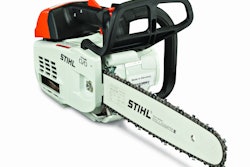
While some species of birds head south for the winter, there are still plenty left behind that have to stick it out in the cold.
Birds have many adaptations to stay warm during the winter months and one of those is a high fat density. In order to maintain that, birds must spend the bulk of their days searching for food, which is scarce in the winter.
If your clients have a love for bird watching, these are some plants that can provide food and shelter for birds during the bitter months and turn backyards into bird sanctuaries.
________________________________________________________
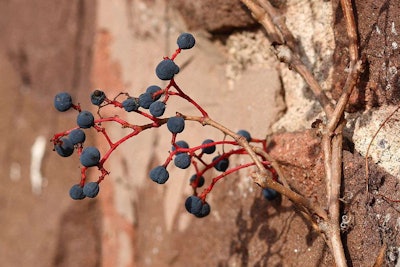 Photo: Wikipedia
Photo: WikipediaVirginia Creeper (Parthenocisus quinquefolia)
This is a fast-growing vine that can grow just about anywhere. Its dark green leaves turn a bright scarlet in the fall and the vine provides small dark purple berries in the winter for birds. It attracts a multitude of species, including bluebirds, thrushes, catbirds, cardinals, starlings, and robins. It can be used as a groundcover or a climbing vine.
- USDA Hardiness Zone: 4-9
- Partial to full sun
________________________________________________________
 Photo: JanetandPhil/Flickr
Photo: JanetandPhil/FlickrNorthern Bayberry (Myrica pennsylvanica)
A dense semi-evergreen shrub that can be used for hedges and screens, Northern Bayberry is a fragrant plant and has a tolerance for winter salt spray. Its small, waxy white berries attract birds such as bluebirds, catbirds, chickadees, and yellow-rumped warblers, as well as tree swallows. Bayberry needs male and female plants to grow berries. This plant also provides nest sites and cover for birds.
- USDA Hardiness Zone: 4-6
- Partial to full sun
________________________________________________________
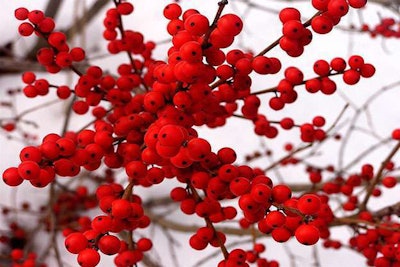 Photo: Liz West/Flickr
Photo: Liz West/FlickrWinterberry (Ilex verticillata)
A species of holly, this deciduous shrub brightens up any landscape with its vibrant red berries that birds can feast on. It attracts cedar waxwings, robins, bluebirds, and others. In order for winterberry to produce fruit, a male must be planted near the female, as this plant, like Northern Bayberry, is dioecious.
- USDA Hardiness Zone: 3-9
- Full to partial shade
________________________________________________________
 Photo: Monrovia
Photo: MonroviaBlue Muffin Arrowwood Viburnum (Viburnum dentatum ‘Christom’)
A compact version of arrowwood viburnum, it can be used for borders, mass plantings, or screens. Blue Muffin features pea-size, bright blue berries that birds such as thrushes, finches, waxwings, and mockingbirds consume. It is also deer-resistant and only requires regular watering during periods of extreme heat.
- USDA Hardiness Zone: 3-8
- Partial to full sun
________________________________________________________
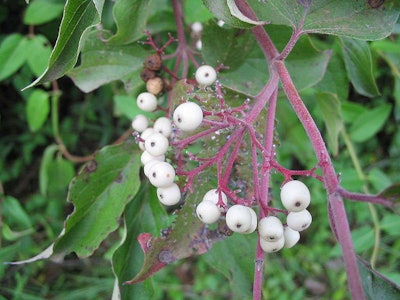 Photo: Wikipedia
Photo: WikipediaGray Dogwood (Cornus racemosa)
A dense, spreading shrub, this dogwood provides interest in multiple seasons and can be used in mass plantings and borders. Its distinctive red stems contrast with its creamy white fruit. It attracts bobwhites, woodpeckers, cardinals, and grosbeaks. It also provides a nest site and cover for birds.
- USDA Hardiness Zone: 4-8
- Full sun to partial shade
________________________________________________________
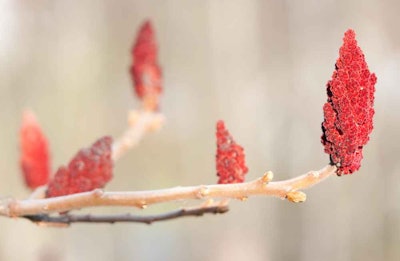 Photo: Shutterstock
Photo: ShutterstockStaghorn Sumac (Rhus typhina)
With hairy twigs that resemble deer antlers in velvet, there’s no mystery about where this sumac’s name came from. Staghorn sumac is the largest of the North American sumacs and works best in informal landscapes. Its hairy red fruit feeds many kinds of birds, including robins, thrushes, starlings, cardinals, chickadees, and bluebirds, to name a few.
- USDA Hardiness Zone: 3-8
- Full sun to partial shade
________________________________________________________
 Photo: Wikipedia
Photo: WikipediaFirethorn (Pyracantha)
A fast-growing evergreen shrub, firethorn can be trained to grow up walls or planted as a hedge. It has glossy green leaves and is thorny, as its name suggests. This plant provides both shelter and food to birds with its fiery red berries. It is low maintenance and attracts thrushes and blackbirds, along with many others.
- USDA Hardiness Zone: 6-9
- Full sun to partial shade
________________________________________________________
Black Chokeberry (Aronia melanocarpa)
This deciduous shrub can be used in shrub borders and foundation lines. It offers attractive seasonal changes with its foliage. Once established, it requires very little watering. It produces shiny black berries that most people consider foul-tasting, but birds love. Grouse, cedar waxwings, northern flickers, and thrashers are just a few of the birds that partake of this plant’s fruit.
- USDA Hardiness Zone: 3-9
- Partial to full sun

